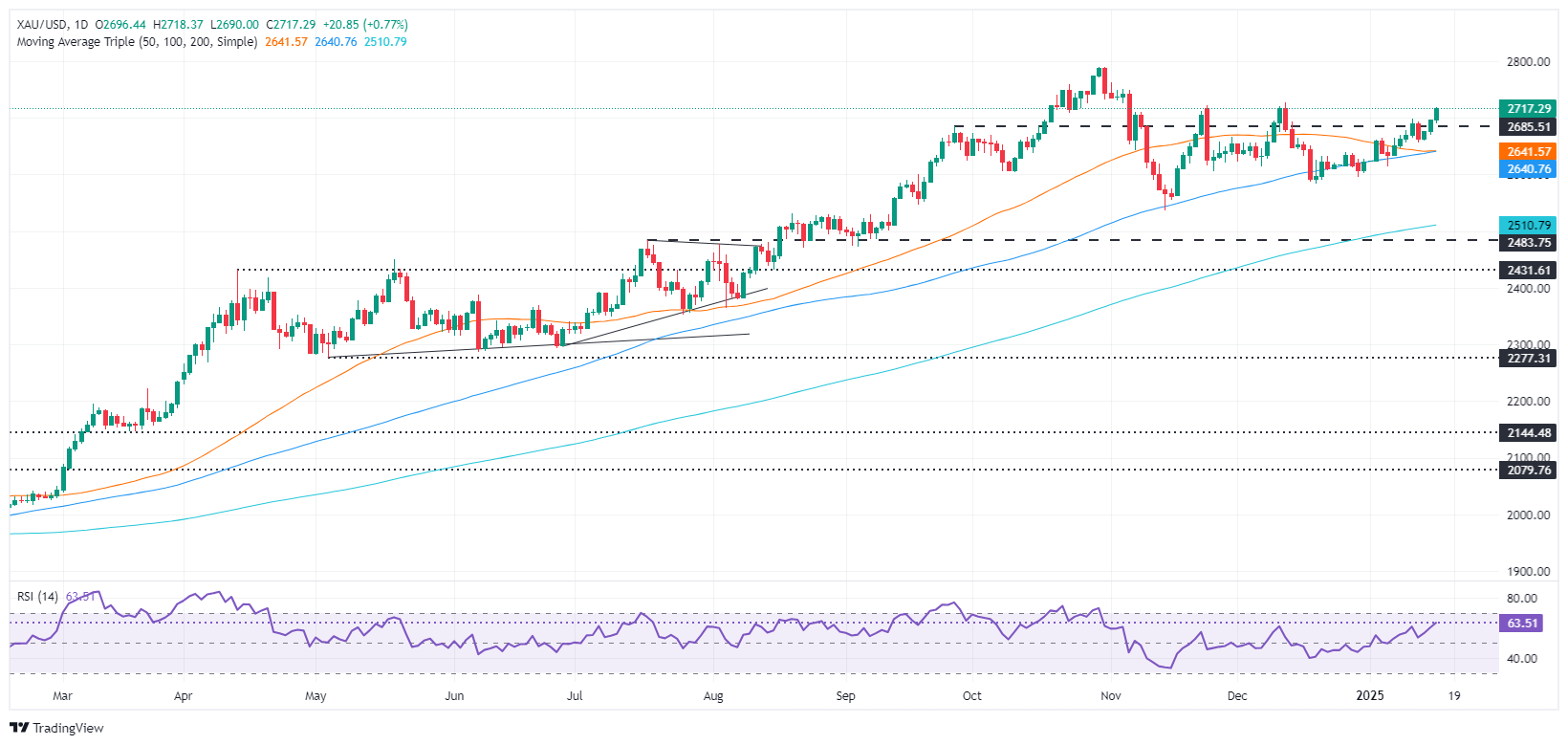- Analytics
- News and Tools
- Market News
- Gold Price Forecast: XAU/USD rallies to one-month peak above $2,700
Gold Price Forecast: XAU/USD rallies to one-month peak above $2,700
- Gold rallies as U.S. Treasury yields dip after rising unemployment claims and strong consumer spending.
- Retail sales up 0.4% MoM in December, November's figures revised up to 0.8%.
- Expectations for 2025 Fed rate cuts grow, with two reductions anticipated by year-end.
Gold soared after economic data from the United States (US) showed that consumer spending remained solid, while the number of people filing for unemployment benefits rose. This weighed on US Treasury yields and boosted the precious metal, which traded above the $2,700 figure for the first time since December last year.
Gold ascends to new highs, surpassed $2,700 as trades eye further Fed rate cuts
The yellow metal and the Greenback are trending up after Retail Sales for December rose by 0.4% MoM, missing the mark, but an upward revision of November figures to 0.8% showed the economy remains robust. On the negative front, Initial Jobless Claims for the week ending January 11 increased by 217K from 201K in the previous week, missing estimates of 210K.
Even though Retail Sales were solid and the US Treasury yield remained firm, Bullion buyers remained in charge, driving prices higher. Wednesday’s US inflation figures increased the chances that the Federal Reserve (Fed) will further ease policy in 2025.
Market participants are pricing in near-even odds that the Fed would cut rates twice by the end of 2025 and see the first reduction in June.
Recent Fed speaking has shown that officials remained concerned about the upcoming Trump administration's policies, some of which, like applying tariffs, are inflation-prone.
Ahead this week the economic docket will feature housing data and the release of US Industrial Production data.
XAU/USD Price Forecast: Technical outlook
Gold’s uptrend is set to continue, but buyers will face key resistance at $2,726, the December 12 high. A breach of the latter will expose $2,750 and the record high of $2,790. Conversely, if XAU/USD slips below $2,700, a pullback is seen toward the January 13 swing low of $2,656.
Momentum favors further upside, as the Relative Strength Index (RSI) depicts.
Gold FAQs
Gold has played a key role in human’s history as it has been widely used as a store of value and medium of exchange. Currently, apart from its shine and usage for jewelry, the precious metal is widely seen as a safe-haven asset, meaning that it is considered a good investment during turbulent times. Gold is also widely seen as a hedge against inflation and against depreciating currencies as it doesn’t rely on any specific issuer or government.
Central banks are the biggest Gold holders. In their aim to support their currencies in turbulent times, central banks tend to diversify their reserves and buy Gold to improve the perceived strength of the economy and the currency. High Gold reserves can be a source of trust for a country’s solvency. Central banks added 1,136 tonnes of Gold worth around $70 billion to their reserves in 2022, according to data from the World Gold Council. This is the highest yearly purchase since records began. Central banks from emerging economies such as China, India and Turkey are quickly increasing their Gold reserves.
Gold has an inverse correlation with the US Dollar and US Treasuries, which are both major reserve and safe-haven assets. When the Dollar depreciates, Gold tends to rise, enabling investors and central banks to diversify their assets in turbulent times. Gold is also inversely correlated with risk assets. A rally in the stock market tends to weaken Gold price, while sell-offs in riskier markets tend to favor the precious metal.
The price can move due to a wide range of factors. Geopolitical instability or fears of a deep recession can quickly make Gold price escalate due to its safe-haven status. As a yield-less asset, Gold tends to rise with lower interest rates, while higher cost of money usually weighs down on the yellow metal. Still, most moves depend on how the US Dollar (USD) behaves as the asset is priced in dollars (XAU/USD). A strong Dollar tends to keep the price of Gold controlled, whereas a weaker Dollar is likely to push Gold prices up.
© 2000-2025. All rights reserved.
This site is managed by Teletrade D.J. LLC 2351 LLC 2022 (Euro House, Richmond Hill Road, Kingstown, VC0100, St. Vincent and the Grenadines).
The information on this website is for informational purposes only and does not constitute any investment advice.
The company does not serve or provide services to customers who are residents of the US, Canada, Iran, The Democratic People's Republic of Korea, Yemen and FATF blacklisted countries.
Making transactions on financial markets with marginal financial instruments opens up wide possibilities and allows investors who are willing to take risks to earn high profits, carrying a potentially high risk of losses at the same time. Therefore you should responsibly approach the issue of choosing the appropriate investment strategy, taking the available resources into account, before starting trading.
Use of the information: full or partial use of materials from this website must always be referenced to TeleTrade as the source of information. Use of the materials on the Internet must be accompanied by a hyperlink to teletrade.org. Automatic import of materials and information from this website is prohibited.
Please contact our PR department if you have any questions or need assistance at pr@teletrade.global.
















